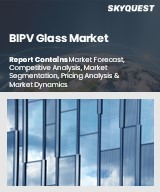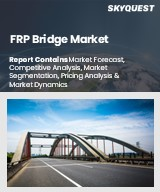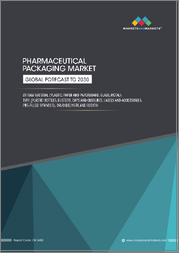
|
시장보고서
상품코드
1576834
세계의 유리 연마용 슬러리 시장 : 최종 이용 산업, 용도, 제품 유형별 예측(2025-2030년)Glass Polishing Slurry Market by End-Use Industry (Aerospace Industry, Optical Industry, Semiconductor Industry), Application (Edge Polishing, Other Applications, Surface Polishing), Product Type - Global Forecast 2025-2030 |
||||||
유리 연마용 슬러리 시장은 2023년에 1억 536만 달러로 평가되었고, 2024년에는 1억 1,247만 달러에 이를 것으로 예측되며, CAGR 7.44%로 성장하여 2030년에는 1억 7,413만 달러에 달할 것으로 예상됩니다.
유리 연마용 슬러리 세계 시장은 전자, 자동차, 항공우주 등 다양한 산업에서 유리 표면의 정밀 연마 및 마무리에 사용되는 것으로 정의됩니다. 고품질의 결함이 없는 유리에 대한 수요가 증가함에 따라 효율적이고 고성능인 연마 솔루션의 필요성이 가장 중요해지고 있습니다. 주로 산화세륨 또는 기타 연마제로 구성된 유리 마루 슬러리는 LCD 유리 제조, 광학 유리 마감, 반도체 세척과 같은 응용 분야의 핵심입니다. 최종 용도의 범위는 여러 섹터에 걸쳐 있으며, 각각이 기술의 진보와 고도화하는 제품의 생산을 통해 성장을 가속하고 있습니다. 성장에 영향을 미치는 요인으로는 정교한 디자인의 가전제품과 우수한 품질의 유리가 필요한 고급 자동차 기술에 대한 수요의 급증이 있습니다. 게다가, 재생가능한 에너지로의 이동은 정밀하게 연마된 태양 전지판에 대한 요구를 증가시켜 슬러리 제조업체에게 큰 비즈니스 기회가 되고 있습니다.
| 주요 시장 통계 | |
|---|---|
| 기준년(2023) | 1억 536만 달러 |
| 예측년(2024) | 1억 1,247만 달러 |
| 예측년(2030) | 1억 7,413만 달러 |
| CAGR(%) | 7.44% |
최근의 동향으로부터 기업이 환경에 대한 영향과 운용 비용의 억제를 목표로 하고 있기 때문에 환경에 부드럽고 비용 효율적인 슬러리 솔루션의 개발에 큰 기회가 있는 것을 알 수 있습니다. 나노입자나 하이브리드 재료 기반의 슬러리 등, 연마 프로세스의 효율과 효력의 강화에 중점을 둔 기술 혁신이 성장의 새로운 길을 열고 있습니다. 그러나 시장은 높은 생산 비용과 진화하는 규제 상황에 의한 제약에 직면하고 있으며 일관된 기술 혁신과 적응이 요구되고 있습니다. 또한 원료 가격의 변동과 고급 대체품의 이용 가능성과 같은 과제도 발생하고 있습니다.
잠재적인 비즈니스 기회를 활용하기 위해 기업은 특히 유연한 전자 제품 및 증강현실(AR) 장치와 같은 특수 용도에서 제품 차별화 및 성능 향상을 목표로 하는 R&D 활동에 투자해야 합니다. 기술 선진기업과의 협업은 새로운 요구와 선호에 대한 통찰력을 제공할 수 있으며, 미개척 지역 시장으로의 전략적 진출도 배당을 초래할 수 있습니다. 지속 가능한 이니셔티브를 중시하는 것은 세계 환경 목표에 부응할 뿐만 아니라 경쟁력을 높일 수 있습니다. 시장의 성격은 매우 역동적이며, 급속한 기술 진보와 소비자의 기대 변화를 특징으로 하므로 민첩성과 적극적인 전략 입안이 필요합니다.
시장 역학: 빠르게 진화하는 유리 연마용 슬러리 시장의 주요 시장 인사이트 공개
유리 연마용 슬러리 시장은 수요 및 공급의 역동적인 상호작용에 의해 변모하고 있습니다. 이러한 시장 역학의 진화를 이해함으로써 기업은 충분한 정보를 바탕으로 투자결정, 전략적 결정 정밀화, 새로운 비즈니스 기회 획득에 대비할 수 있습니다. 이러한 동향을 종합적으로 파악함으로써 기업은 정치적, 지리적, 기술적, 사회적, 경제적 영역에 걸친 다양한 위험을 완화할 수 있으며, 소비자 행동과 그것이 제조 비용과 구매 동향에 미치는 영향을보다 명확하게 이해할 수 있습니다.
- 시장 성장 촉진요인
- 태양전지 및 반도체 제조에 있어서의 유리 베이스의 부품의 사용량 증가
- 효율과 성능을 높이는 유리 연마 기술의 진보
- 유리 연마 공정에서 환경 친화적이고 지속 가능한 재료를 사용하는 경향이 증가
- 시장 성장 억제요인
- 공급망의 혼란과 비용 변동으로 이어지는 원료의 입수 제한
- 유리 연마용 슬러리의 채용에 영향을 미치는 대체 연마 기술과의 격렬한 경쟁
- 시장 기회
- 소비자용 전자기기 분야에서의 고도의 유리 연마 기술에 대한 수요 증가
- 태양에너지 분야의 확대에 의한 고품질 유리 연마 솔루션 수요 증가
- 시장의 과제
- 유리 연마용 슬러리의 가격 상승으로 이어지는 원재료의 고비용과 공급 체인의 혼란
- 고정밀 유리 연마 용도에 필수적인 초미세 마감을 달성하기 위한 기술적 한계
Porter's Five Forces: 유리 연마용 슬러리 시장을 탐색하는 전략 도구
Porter's Five Forces 프레임 워크는 시장 상황경쟁 구도를 이해하는 중요한 도구입니다. Porter's Five Force Framework는 기업의 경쟁력을 평가하고 전략적 기회를 탐구하는 명확한 기술을 제공합니다. 이 프레임워크는 기업이 시장 내 세력도를 평가하고 신규 사업의 수익성을 결정하는 데 도움이 됩니다. 이러한 통찰을 통해 기업은 자사의 강점을 활용하고, 약점을 해결하고, 잠재적인 과제를 피할 수 있으며, 보다 강인한 시장에서의 포지셔닝을 보장할 수 있습니다.
PESTLE 분석 : 유리 연마용 슬러리 시장에서 외부로부터의 영향 파악
외부 거시 환경 요인은 유리 연마용 슬러리 시장의 성과 역학을 형성하는데 매우 중요한 역할을 합니다. 정치적, 경제적, 사회적, 기술적, 법적, 환경적 요인 분석은 이러한 영향을 탐색하는 데 필요한 정보를 제공합니다. PESTLE 요인을 조사함으로써 기업은 잠재적인 위험과 기회를 더 잘 이해할 수 있습니다. 이 분석을 통해 기업은 규제, 소비자 선호, 경제 동향의 변화를 예측하고 앞으로 예상되는 적극적인 의사 결정을 할 준비를 할 수 있습니다.
시장 점유율 분석 : 유리 연마용 슬러리 시장 경쟁 구도 파악
유리 연마용 슬러리 시장의 상세한 시장 점유율 분석을 통해 공급업체의 성과를 종합적으로 평가할 수 있습니다. 기업은 수익, 고객 기반, 성장률 등 주요 지표를 비교하여 경쟁 포지셔닝을 밝힐 수 있습니다. 이 분석을 통해 시장 집중, 단편화, 통합 동향을 밝혀내고 벤더들은 경쟁이 치열해지는 가운데 자사의 지위를 높이는 전략적 의사 결정을 내리는 데 필요한 지식을 얻을 수 있습니다.
FPNV 포지셔닝 매트릭스 : 유리 연마용 슬러리 시장에서 공급업체의 성능 평가
FPNV 포지셔닝 매트릭스는 유리 연마용 슬러리 시장에서 공급업체를 평가하는 중요한 도구입니다. 이 행렬을 통해 비즈니스 조직은 공급업체의 비즈니스 전략과 제품 만족도를 기준으로 평가하여 목표에 맞는 충분한 정보를 바탕으로 의사 결정을 내릴 수 있습니다. 네 가지 사분면을 통해 공급업체를 명확하고 정확하게 세분화하여 전략 목표에 가장 적합한 파트너 및 솔루션을 파악할 수 있습니다.
전략 분석 및 권장 : 유리 연마용 슬러리 시장에서 성공을 위한 길을 그리기
유리 연마용 슬러리 시장의 전략 분석은 세계 시장에서의 프레즌스 강화를 목표로 하는 기업에 필수적입니다. 주요 자원, 능력 및 성과 지표를 검토함으로써 기업은 성장 기회를 파악하고 개선을 위해 노력할 수 있습니다. 이러한 접근 방식을 통해 경쟁 구도에서 과제를 극복하고 새로운 비즈니스 기회를 활용하여 장기적인 성공을 거둘 수 있는 체제를 구축할 수 있습니다.
이 보고서는 주요 관심 분야를 포괄하는 시장의 종합적인 분석을 제공합니다.
1. 시장 침투: 현재 시장 환경의 상세한 검토, 주요 기업의 광범위한 데이터, 시장 도달범위 및 전반적인 영향력 평가.
2. 시장 개척도: 신흥 시장의 성장 기회를 파악하고 기존 분야의 확장 가능성을 평가하며 미래 성장을 위한 전략적 로드맵을 제공합니다.
3. 시장 다양화: 최근 제품 출시, 미개척 지역, 업계의 주요 진보, 시장을 형성하는 전략적 투자를 분석합니다.
4. 경쟁 평가 및 정보 : 경쟁 구도를 철저히 분석하여 시장 점유율, 사업 전략, 제품 포트폴리오, 인증, 규제 당국 승인, 특허 동향, 주요 기업의 기술 진보 등을 검증합니다.
5. 제품 개발 및 혁신 : 미래 시장 성장을 가속할 것으로 예상되는 최첨단 기술, R&D 활동, 제품 혁신을 강조합니다.
또한 이해관계자가 충분한 정보를 얻고 의사결정을 할 수 있도록 중요한 질문에 대답하고 있습니다.
1. 현재 시장 규모와 향후 성장 예측은?
2. 최고의 투자 기회를 제공하는 제품, 부문 및 지역은 어디입니까?
3. 시장을 형성하는 주요 기술 동향과 규제의 영향은?
4. 주요 벤더의 시장 점유율과 경쟁 포지션은?
5. 벤더 시장 진입·철수 전략의 원동력이 되는 수익원과 전략적 기회는 무엇인가?
목차
제1장 서문
제2장 조사 방법
제3장 주요 요약
제4장 시장 개요
제5장 시장 인사이트
- 시장 역학
- 성장 촉진요인
- 태양전지나 반도체 제조에 있어서의 유리 베이스의 부품의 사용 증가
- 효율과 성능을 향상시키는 유리 연마 기술의 진보
- 유리 연마 공정에서 환경 친화적이고 지속 가능한 재료를 사용하는 경향이 높아지고 있다
- 억제요인
- 원재료 공급 부족에 의해 공급 체인의 혼란이나 비용 변동이 생긴다
- 대체 연마 기술과의 격렬한 경쟁이 유리 연마용 슬러리의 채용에 영향을 미치고 있다
- 기회
- 가전제품 분야에 있어서의 고도의 유리 연마 기술 수요 증가
- 태양에너지 분야의 확대로 고품질의 유리 연마 솔루션 수요가 증가
- 과제
- 원재료비의 상승과 공급 체인의 혼란에 의해 유리 연마용 슬러리의 가격이 상승
- 고정밀 유리 연마 용도에 필수적인 초미세 마감을 실현하기 위한 기술적 한계
- 성장 촉진요인
- 시장 세분화 분석
- Porter's Five Forces 분석
- PESTEL 분석
- 정치적
- 경제
- 사교
- 기술적
- 법률상
- 환경
제6장 유리 연마용 슬러리 시장 : 최종 이용 산업별
- 항공우주산업
- 항공기 창
- 유리
- 광학산업
- 디스플레이 패널
- 렌즈 제조
- 반도체 산업
- 로직
- 메모리
- 마이크로 일렉트로메카니컬 시스템(MEMS)
제7장 유리 연마용 슬러리 시장 : 용도별
- 엣지 연마
- 플랫 패널
- 광학 부품
- 기타 용도
- 광섬유
- 태양전지
- 표면 연마
- 유리 기판
- 실리콘 웨이퍼
제8장 유리 연마용 슬러리 시장 : 제품 유형별
- 알루미나계 슬러리
- CeO2계 슬러리
- 실리카 베이스 슬러리
제9장 아메리카의 유리 연마용 슬러리 시장
- 아르헨티나
- 브라질
- 캐나다
- 멕시코
- 미국
제10장 아시아태평양의 유리 연마용 슬러리 시장
- 호주
- 중국
- 인도
- 인도네시아
- 일본
- 말레이시아
- 필리핀
- 싱가포르
- 한국
- 대만
- 태국
- 베트남
제11장 유럽·중동 및 아프리카의 유리 연마용 슬러리 시장
- 덴마크
- 이집트
- 핀란드
- 프랑스
- 독일
- 이스라엘
- 이탈리아
- 네덜란드
- 나이지리아
- 노르웨이
- 폴란드
- 카타르
- 러시아
- 사우디아라비아
- 남아프리카
- 스페인
- 스웨덴
- 스위스
- 터키
- 아랍에미리트(UAE)
- 영국
제12장 경쟁 구도
- 시장 점유율 분석 2023
- FPNV 포지셔닝 매트릭스, 2023
- 경쟁 시나리오 분석
- 전략 분석과 제안
The Glass Polishing Slurry Market was valued at USD 105.36 million in 2023, expected to reach USD 112.47 million in 2024, and is projected to grow at a CAGR of 7.44%, to USD 174.13 million by 2030.
The global glass polishing slurry market is defined by its use in the precision polishing and finishing of glass surfaces across various industries, including electronics, automotive, and aerospace. As the demand for high-quality, defect-free glass increases, the necessity for efficient and high-performance polishing solutions becomes paramount. Glass polishing slurries, primarily composed of cerium oxide or other abrasives, are central to applications like LCD glass production, optical glass finishing, and cleaning of semiconductors. The end-use scope spans across multiple sectors, each driving growth through technological advancements and the production of increasingly sophisticated products. Factors influencing growth include a surge in demand for consumer electronics with sleek designs and advanced automotive technologies that require superior quality glass. Moreover, the shift towards renewable energy sources is enhancing the need for precisely polished solar panels, offering significant opportunities for slurry manufacturers.
| KEY MARKET STATISTICS | |
|---|---|
| Base Year [2023] | USD 105.36 million |
| Estimated Year [2024] | USD 112.47 million |
| Forecast Year [2030] | USD 174.13 million |
| CAGR (%) | 7.44% |
Recent trends reveal a substantial opportunity in the development of eco-friendly and cost-efficient slurry solutions as businesses aim to curb environmental impact and operational costs. Innovations focused on enhancing the efficiency and efficacy of polishing processes, such as nanoparticles or hybrid material-based slurries, are paving new pathways for growth. However, the market faces limitations from high production costs and the evolving regulatory landscape, which demand consistent innovation and adaptation. Challenges also arise from raw material price volatility and the availability of advanced substitutes.
To capitalize on potential opportunities, firms should invest in R&D activities that target product differentiation and performance improvement, particularly in specialized applications like flexible electronics or augmented reality devices. Collaborations with tech-forward companies could offer insights into emerging needs and preferences, while strategic expansion into untapped regional markets may also yield dividends. Emphasizing sustainable practices will not only align with global environmental goals but also build a competitive edge. The market's nature is highly dynamic, characterized by rapid technological advancements and shifting consumer expectations, which necessitates agility and proactive strategic planning.
Market Dynamics: Unveiling Key Market Insights in the Rapidly Evolving Glass Polishing Slurry Market
The Glass Polishing Slurry Market is undergoing transformative changes driven by a dynamic interplay of supply and demand factors. Understanding these evolving market dynamics prepares business organizations to make informed investment decisions, refine strategic decisions, and seize new opportunities. By gaining a comprehensive view of these trends, business organizations can mitigate various risks across political, geographic, technical, social, and economic domains while also gaining a clearer understanding of consumer behavior and its impact on manufacturing costs and purchasing trends.
- Market Drivers
- Growing usage of glass-based components in photovoltaic cells and semiconductor manufacturing
- Advancements in glass polishing technologies enhancing efficiency and performance
- Rising trend towards using eco-friendly and sustainable materials in glass polishing processes
- Market Restraints
- Limited availability of raw materials leading to supply chain disruptions and cost fluctuations
- Intense competition from alternative abrasive technologies impacting the adoption of glass polishing slurries
- Market Opportunities
- Increasing demand for advanced glass polishing technologies in the consumer electronics sector
- Expansion of the solar energy sector spurring demand for high-quality glass polishing solutions
- Market Challenges
- High cost of raw materials and supply chain disruptions leading to increased prices for glass polishing slurries
- Technical limitations in achieving ultra-fine finishes essential for high-precision glass polishing applications
Porter's Five Forces: A Strategic Tool for Navigating the Glass Polishing Slurry Market
Porter's five forces framework is a critical tool for understanding the competitive landscape of the Glass Polishing Slurry Market. It offers business organizations with a clear methodology for evaluating their competitive positioning and exploring strategic opportunities. This framework helps businesses assess the power dynamics within the market and determine the profitability of new ventures. With these insights, business organizations can leverage their strengths, address weaknesses, and avoid potential challenges, ensuring a more resilient market positioning.
PESTLE Analysis: Navigating External Influences in the Glass Polishing Slurry Market
External macro-environmental factors play a pivotal role in shaping the performance dynamics of the Glass Polishing Slurry Market. Political, Economic, Social, Technological, Legal, and Environmental factors analysis provides the necessary information to navigate these influences. By examining PESTLE factors, businesses can better understand potential risks and opportunities. This analysis enables business organizations to anticipate changes in regulations, consumer preferences, and economic trends, ensuring they are prepared to make proactive, forward-thinking decisions.
Market Share Analysis: Understanding the Competitive Landscape in the Glass Polishing Slurry Market
A detailed market share analysis in the Glass Polishing Slurry Market provides a comprehensive assessment of vendors' performance. Companies can identify their competitive positioning by comparing key metrics, including revenue, customer base, and growth rates. This analysis highlights market concentration, fragmentation, and trends in consolidation, offering vendors the insights required to make strategic decisions that enhance their position in an increasingly competitive landscape.
FPNV Positioning Matrix: Evaluating Vendors' Performance in the Glass Polishing Slurry Market
The Forefront, Pathfinder, Niche, Vital (FPNV) Positioning Matrix is a critical tool for evaluating vendors within the Glass Polishing Slurry Market. This matrix enables business organizations to make well-informed decisions that align with their goals by assessing vendors based on their business strategy and product satisfaction. The four quadrants provide a clear and precise segmentation of vendors, helping users identify the right partners and solutions that best fit their strategic objectives.
Strategy Analysis & Recommendation: Charting a Path to Success in the Glass Polishing Slurry Market
A strategic analysis of the Glass Polishing Slurry Market is essential for businesses looking to strengthen their global market presence. By reviewing key resources, capabilities, and performance indicators, business organizations can identify growth opportunities and work toward improvement. This approach helps businesses navigate challenges in the competitive landscape and ensures they are well-positioned to capitalize on newer opportunities and drive long-term success.
Key Company Profiles
The report delves into recent significant developments in the Glass Polishing Slurry Market, highlighting leading vendors and their innovative profiles. These include 3M, AGC Inc., BASF SE, Cabot Microelectronics Corporation, CETC Solar Energy Holdings Co., Ltd., Dow Silicones Corporation, DuPont de Nemours, Inc., Ecolab Inc., Evonik Industries AG, Ferro Corporation, Fujimi Incorporated, Merck KGaA, Nanophase Technologies Corporation, Nippon Sheet Glass Co., Ltd., Noritake Co., Limited, Pureon AG, Saint-Gobain, Soulbrain Holdings Co., Ltd., Universal Photonics Incorporated, and Wacker Chemie AG.
Market Segmentation & Coverage
This research report categorizes the Glass Polishing Slurry Market to forecast the revenues and analyze trends in each of the following sub-markets:
- Based on End-Use Industry, market is studied across Aerospace Industry, Optical Industry, and Semiconductor Industry. The Aerospace Industry is further studied across Aircraft Windows and Mirrors. The Optical Industry is further studied across Display Panels and Lens Manufacturing. The Semiconductor Industry is further studied across Logic, Memory, and Microelectromechanical Systems (MEMS).
- Based on Application, market is studied across Edge Polishing, Other Applications, and Surface Polishing. The Edge Polishing is further studied across Flat Panels and Optical Components. The Other Applications is further studied across Fiber Optics and Photovoltaic Cells. The Surface Polishing is further studied across Glass Substrates and Silicon Wafers.
- Based on Product Type, market is studied across Alumina-Based Slurries, CeO2-Based Slurries, and Silica-Based Slurries.
- Based on Region, market is studied across Americas, Asia-Pacific, and Europe, Middle East & Africa. The Americas is further studied across Argentina, Brazil, Canada, Mexico, and United States. The United States is further studied across California, Florida, Illinois, New York, Ohio, Pennsylvania, and Texas. The Asia-Pacific is further studied across Australia, China, India, Indonesia, Japan, Malaysia, Philippines, Singapore, South Korea, Taiwan, Thailand, and Vietnam. The Europe, Middle East & Africa is further studied across Denmark, Egypt, Finland, France, Germany, Israel, Italy, Netherlands, Nigeria, Norway, Poland, Qatar, Russia, Saudi Arabia, South Africa, Spain, Sweden, Switzerland, Turkey, United Arab Emirates, and United Kingdom.
The report offers a comprehensive analysis of the market, covering key focus areas:
1. Market Penetration: A detailed review of the current market environment, including extensive data from top industry players, evaluating their market reach and overall influence.
2. Market Development: Identifies growth opportunities in emerging markets and assesses expansion potential in established sectors, providing a strategic roadmap for future growth.
3. Market Diversification: Analyzes recent product launches, untapped geographic regions, major industry advancements, and strategic investments reshaping the market.
4. Competitive Assessment & Intelligence: Provides a thorough analysis of the competitive landscape, examining market share, business strategies, product portfolios, certifications, regulatory approvals, patent trends, and technological advancements of key players.
5. Product Development & Innovation: Highlights cutting-edge technologies, R&D activities, and product innovations expected to drive future market growth.
The report also answers critical questions to aid stakeholders in making informed decisions:
1. What is the current market size, and what is the forecasted growth?
2. Which products, segments, and regions offer the best investment opportunities?
3. What are the key technology trends and regulatory influences shaping the market?
4. How do leading vendors rank in terms of market share and competitive positioning?
5. What revenue sources and strategic opportunities drive vendors' market entry or exit strategies?
Table of Contents
1. Preface
- 1.1. Objectives of the Study
- 1.2. Market Segmentation & Coverage
- 1.3. Years Considered for the Study
- 1.4. Currency & Pricing
- 1.5. Language
- 1.6. Stakeholders
2. Research Methodology
- 2.1. Define: Research Objective
- 2.2. Determine: Research Design
- 2.3. Prepare: Research Instrument
- 2.4. Collect: Data Source
- 2.5. Analyze: Data Interpretation
- 2.6. Formulate: Data Verification
- 2.7. Publish: Research Report
- 2.8. Repeat: Report Update
3. Executive Summary
4. Market Overview
5. Market Insights
- 5.1. Market Dynamics
- 5.1.1. Drivers
- 5.1.1.1. Growing usage of glass-based components in photovoltaic cells and semiconductor manufacturing
- 5.1.1.2. Advancements in glass polishing technologies enhancing efficiency and performance
- 5.1.1.3. Rising trend towards using eco-friendly and sustainable materials in glass polishing processes
- 5.1.2. Restraints
- 5.1.2.1. Limited availability of raw materials leading to supply chain disruptions and cost fluctuations
- 5.1.2.2. Intense competition from alternative abrasive technologies impacting the adoption of glass polishing slurries
- 5.1.3. Opportunities
- 5.1.3.1. Increasing demand for advanced glass polishing technologies in the consumer electronics sector
- 5.1.3.2. Expansion of the solar energy sector spurring demand for high-quality glass polishing solutions
- 5.1.4. Challenges
- 5.1.4.1. High cost of raw materials and supply chain disruptions leading to increased prices for glass polishing slurries
- 5.1.4.2. Technical limitations in achieving ultra-fine finishes essential for high-precision glass polishing applications
- 5.1.1. Drivers
- 5.2. Market Segmentation Analysis
- 5.3. Porter's Five Forces Analysis
- 5.3.1. Threat of New Entrants
- 5.3.2. Threat of Substitutes
- 5.3.3. Bargaining Power of Customers
- 5.3.4. Bargaining Power of Suppliers
- 5.3.5. Industry Rivalry
- 5.4. PESTLE Analysis
- 5.4.1. Political
- 5.4.2. Economic
- 5.4.3. Social
- 5.4.4. Technological
- 5.4.5. Legal
- 5.4.6. Environmental
6. Glass Polishing Slurry Market, by End-Use Industry
- 6.1. Introduction
- 6.2. Aerospace Industry
- 6.2.1. Aircraft Windows
- 6.2.2. Mirrors
- 6.3. Optical Industry
- 6.3.1. Display Panels
- 6.3.2. Lens Manufacturing
- 6.4. Semiconductor Industry
- 6.4.1. Logic
- 6.4.2. Memory
- 6.4.3. Microelectromechanical Systems (MEMS)
7. Glass Polishing Slurry Market, by Application
- 7.1. Introduction
- 7.2. Edge Polishing
- 7.2.1. Flat Panels
- 7.2.2. Optical Components
- 7.3. Other Applications
- 7.3.1. Fiber Optics
- 7.3.2. Photovoltaic Cells
- 7.4. Surface Polishing
- 7.4.1. Glass Substrates
- 7.4.2. Silicon Wafers
8. Glass Polishing Slurry Market, by Product Type
- 8.1. Introduction
- 8.2. Alumina-Based Slurries
- 8.3. CeO2-Based Slurries
- 8.4. Silica-Based Slurries
9. Americas Glass Polishing Slurry Market
- 9.1. Introduction
- 9.2. Argentina
- 9.3. Brazil
- 9.4. Canada
- 9.5. Mexico
- 9.6. United States
10. Asia-Pacific Glass Polishing Slurry Market
- 10.1. Introduction
- 10.2. Australia
- 10.3. China
- 10.4. India
- 10.5. Indonesia
- 10.6. Japan
- 10.7. Malaysia
- 10.8. Philippines
- 10.9. Singapore
- 10.10. South Korea
- 10.11. Taiwan
- 10.12. Thailand
- 10.13. Vietnam
11. Europe, Middle East & Africa Glass Polishing Slurry Market
- 11.1. Introduction
- 11.2. Denmark
- 11.3. Egypt
- 11.4. Finland
- 11.5. France
- 11.6. Germany
- 11.7. Israel
- 11.8. Italy
- 11.9. Netherlands
- 11.10. Nigeria
- 11.11. Norway
- 11.12. Poland
- 11.13. Qatar
- 11.14. Russia
- 11.15. Saudi Arabia
- 11.16. South Africa
- 11.17. Spain
- 11.18. Sweden
- 11.19. Switzerland
- 11.20. Turkey
- 11.21. United Arab Emirates
- 11.22. United Kingdom
12. Competitive Landscape
- 12.1. Market Share Analysis, 2023
- 12.2. FPNV Positioning Matrix, 2023
- 12.3. Competitive Scenario Analysis
- 12.4. Strategy Analysis & Recommendation
Companies Mentioned
- 1. 3M
- 2. AGC Inc.
- 3. BASF SE
- 4. Cabot Microelectronics Corporation
- 5. CETC Solar Energy Holdings Co., Ltd.
- 6. Dow Silicones Corporation
- 7. DuPont de Nemours, Inc.
- 8. Ecolab Inc.
- 9. Evonik Industries AG
- 10. Ferro Corporation
- 11. Fujimi Incorporated
- 12. Merck KGaA
- 13. Nanophase Technologies Corporation
- 14. Nippon Sheet Glass Co., Ltd.
- 15. Noritake Co., Limited
- 16. Pureon AG
- 17. Saint-Gobain
- 18. Soulbrain Holdings Co., Ltd.
- 19. Universal Photonics Incorporated
- 20. Wacker Chemie AG



















